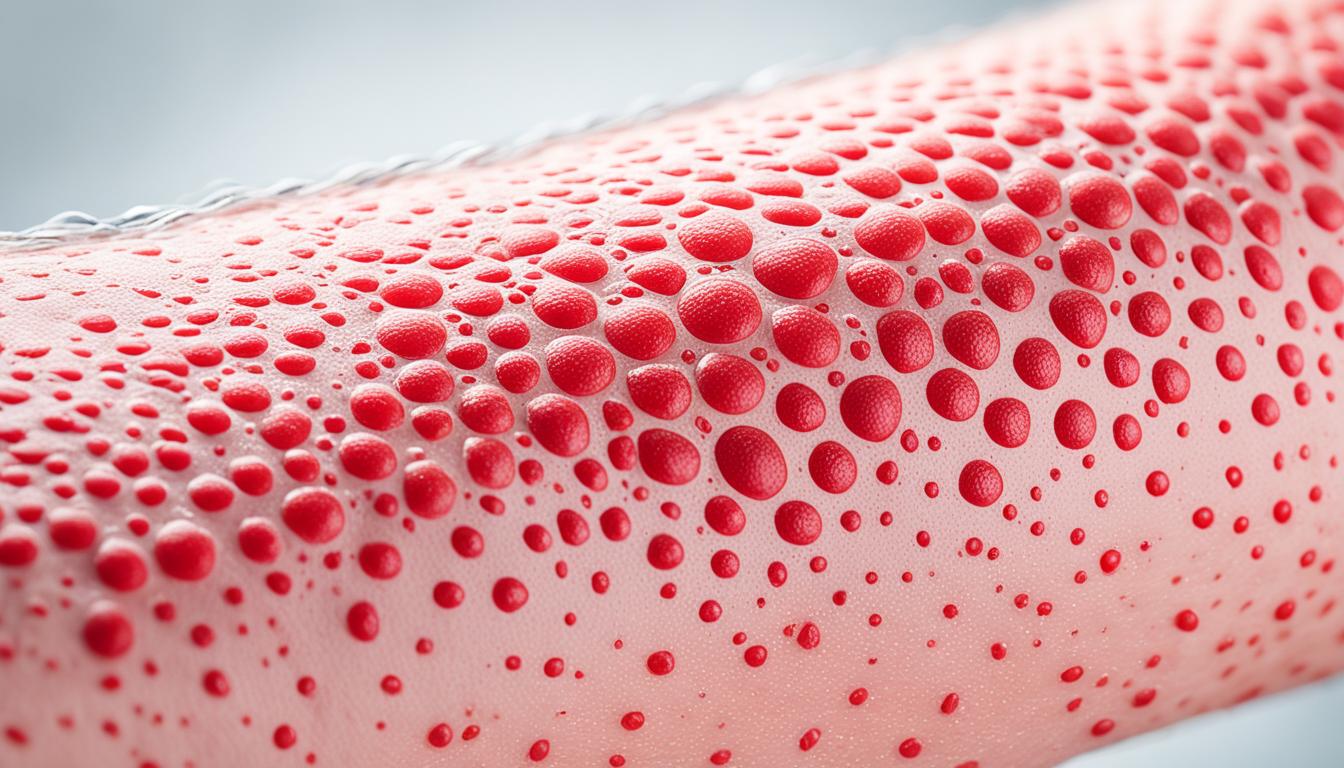KP, or Keratosis pilaris, is common and affects many adults. It shows up as red goosebumps on the arms and legs. The skin feels rough because of too much keratin in the hair follicles. You can help manage KP by exfoliating to remove the extra keratin. Treatment can involve using physical or chemical exfoliators or both. In some severe cases, stem cell therapy might be an option.
Key Takeaways:
- KP, or Keratosis pilaris, is a common skin issue among adults.
- It’s marked by red bumps and skin that feels rough.
- Managing KP involves exfoliating to take away the extra keratin.
- Exfoliators can include physical and chemical types.
- In severe KP, stem cell therapy could be an option.
What is Keratosis Pilaris and its Variants?
Keratosis pilaris (KP) causes red goosebumps on the arms, legs, and buttocks. There are more than 6 types of KP, each with different signs and areas they affect. It’s interesting to learn about these varieties.
KP Rubra Pilaris
KP rubra pilaris targets the face, showing as red bumps on the cheeks. This makes it stand out more and might bother those who have it.
KP Pustulosa
Some may get KP flare-ups, especially when it’s hot. This condition, known as KP pustulosa, leads to pus-filled bumps on the skin during infections.
KP Facei
KP facei affects the cheeks, often causing embarrassment. It appears red and may cause worries because it’s noticeable.
KP Atrophicans
KP atrophicans is less common, showing as small depressions in the skin. They happen due to inflammation in the affected areas.
KP Alba Pilaris
KP alba pilaris looks like white bumps on the skin. It usually is less severe and is tied to dry skin.
A proper KP diagnosis is best done by a dermatologist. They can identify the specific variant and create a treatment just for you.
| KP Variant | Affected Areas | Description |
|---|---|---|
| KP Rubra Pilaris | Face | Red and bumpy skin on the cheeks |
| KP Pustulosa | Various areas | Flare-ups and infection, resulting in pus-filled bumps |
| KP Facei | Cheeks | Redness and cosmetic concern |
| KP Atrophicans | Various areas | Atrophic divots due to inflammation |
| KP Alba Pilaris | Various areas | White bumps on the skin |
Treating and Managing Keratosis Pilaris
Keratosis Pilaris (KP) can be tackled effectively. It needs regular exfoliation and keratolytics’ use. These methods help lessen keratin build-up in follicles, thus enhancing skin look and feel.
Physical and Chemical Exfoliation
Exfoliation plays a crucial role in KP skin care. Physical exfoliation, with a gentle loofah or scrub, removes dead skin cells. It also clears the hair follicles. But, be careful not to scrub too hard. This can make KP worse. Chemical exfoliation uses acids found in skincare. For example, salicylic, glycolic, or lactic acids dissolve keratin plugs. They also boost cell renewal.
Retinoids for Keratosis Pilaris
Retinoids, made from vitamin A, are great for skin.
They boost cell renewal and improve skin texture. Topical retinoids, like tretinoin, adapalene, or tazarotene, are used for KP. These strong treatments speed up the removal of dead cells. They lessen new keratin plugs, making skin smoother.
Consulting a Dermatologist
Seeing a dermatologist for KP is smart. They can pinpoint your KP type and give specific treatments. They might use vascular lasers for redness in some KP types.
Stick to a steady skin care plan with exfoliation and keratolytics. This helps KP symptoms stay low. A dermatologist offers special care for managing KP successfully.
| Treatment Options for KP | Benefits | Considerations |
|---|---|---|
| Physical exfoliation with a loofah | Removes dead skin cells and unclogs hair follicles | Avoid excessive scrubbing to prevent skin irritation |
| Chemical exfoliation with skincare acids | Dissolves keratin plugs and promotes cell turnover | Start with lower concentrations and patch test for skin sensitivity |
| Topical retinoids | Accelerates cell turnover and improves skin texture | Prescription-strength treatment, may cause skin dryness and irritation |
| Consultation with a dermatologist | Personalized treatment plan based on individual skin needs | Ensure proper diagnosis and monitoring for effective management |
Conclusion
Keratosis pilaris (KP) is a skin issue many adults face. Sadly, there’s no cure for it. Yet, there are ways to keep it under control. By regularly exfoliating and using keratolytics, like skincare acids, you can slow down keratin build-up in hair follicles. Topical treatments, such as retinoids, aid shedding and smooth skin.
Seeing a dermatologist if you have KP is very important. They will correctly diagnose which type of KP you have. Then, they’ll suggest the best skincare and treatments. This could include physical or chemical exfoliation, keratolytics, or retinoids. A dermatologist’s advice is key to managing KP well.
With a proper skincare routine and treatments, KP symptoms can get better. Even though KP is long-lasting, with proactive care from a dermatologist, your skin can become healthier and smoother.
FAQ
Q: What is Keratosis Pilaris (KP)?
A: Keratosis Pilaris, or KP, is a skin problem. It makes small red bumps appear on the back of the arms, the front of legs, and sometimes on the buttocks. These bumps happen due to too much keratin in hair follicles.
Q: How common is Keratosis Pilaris?
A: About 1 in 3 adults deal with Keratosis Pilaris. So, it’s quite common among people.
Q: What are the variants of Keratosis Pilaris?
A: Keratosis Pilaris comes in over 6 types. The most seen one affects our arms, legs, and buttocks. Other kinds are KP rubra pilaris, KP pustulosa, and more.
Q: How can Keratosis Pilaris be managed?
A: To handle Keratosis Pilaris, regular exfoliation is key. Using keratolytics helps too. You can exfoliate physically with a loofah or chemically with skincare acids. For serious cases, retinoids or laser therapy might be necessary. It’s best to see a dermatologist for the right treatment for you.

